

The US Department of the Interior has announced that US$1.15bn in funding is available to states from the Bipartisan Infrastructure Law to create jobs cleaning up orphaned oil and gas wells across the country.
This is a key initiative of President Biden’s Bipartisan Infrastructure Law, which allocated a total of US$4.7bn to create a new federal programme to address orphan wells. Millions of Americans across the country live within a mile of an orphaned oil and gas well.
The historic investments to clean up hazardous sites will create good-paying, union jobs, catalyse economic growth and revitalisation, and reduce dangerous methane leaks.
“President Biden’s Bipartisan Infrastructure Law is enabling us to confront the legacy pollution and long-standing environmental injustices that for too long have plagued underrepresented communities,” said Secretary Deb Haaland. “We must act with urgency to address the more than one hundred thousand documented orphaned wells across the country and leave no community behind. This is good for our climate, for the health of our communities, and for American workers.”
Plugging orphaned wells will also help advance the goals of the US Methane Emissions Reduction Action Plan, as well as the Interagency Working Group on Coal and Power Plant Communities and Economic Revitalization, which focuses on spurring economic revitalisation in the hard-hit energy communities.
Nearly every state with documented orphaned wells submitted a Notice of Intent (NOI) showing interest in applying for a formula grant to fund the proper closure and cleanup of orphaned wells and well sites.
The Department released the amount of funding that states are eligible to apply for in Phase One, which includes up to US$25mn in Initial Grant funding and a quarter of the total Formula Grant money available for the 26 states that submitted NOIs. These allocations were determined using the data provided by states from the NOIs and equally considers the following factors required by the Bipartisan Infrastructure Law.
In the coming weeks, the Department will release detailed guidance for states to apply for the Initial Grants. These resources will allow state officials to begin building out their plugging programs, remediating high-priority wells, and collecting additional data regarding the number of orphaned wells in their states.
D&A GOM 2022
At D&A GOM 2022, the offshore community is set to reunite face-to-face to discuss the challenges and opportunities marking decommissioning and abandonment in the region, listen to sessions delving into current complex situations and network to help each other optimise their strategies. To find out more, download the brochure: https://offsnet.com/da-gom/conference-brochure
Or contact:
Joseph Watson
Project Manager
Offshore Network Ltd.
t: +44 (0) 20 3409 5720
e:
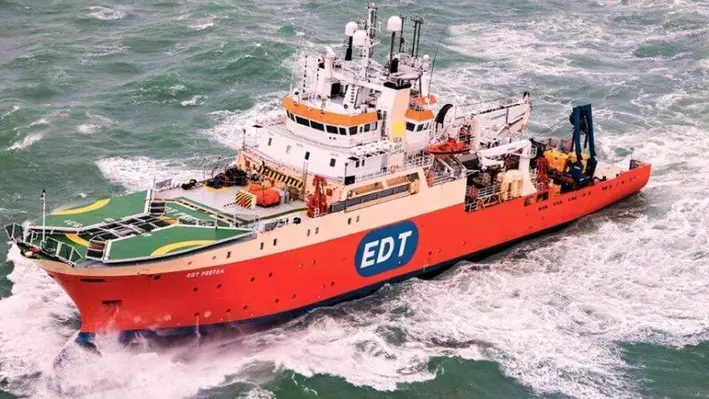
 N-Sea Group has signed a long-term vessel agreement with EDT Offshore for the EDT Protea, which has a strong track record in Subsea services in both AIR diving and ROV intervention works.
N-Sea Group has signed a long-term vessel agreement with EDT Offshore for the EDT Protea, which has a strong track record in Subsea services in both AIR diving and ROV intervention works.
With its sleek design and DP3 capability, the advanced DP-3 Multi-Purpose Offshore Support Vessel is ideal for working in close proximity to assets. This, along with a 50t AHC crane, forms the perfect platform for total subsea solutions. The vessel holds a solid track record for continuous diving operations in the North Sea for many years.
N-Sea has taken significant steps of planned growth; creating a sound and healthy environment that warrants investments, establishes strong strategic partnerships, and sets the stage for long-term client relationships.
As well as the previously announced agreement with Geo Plus for the Geo Focus, the EDT Protea is one of the six vessels that N-Sea will have under full management and control. By having long term control over vessels, it allows N-Sea to provide safer, and more efficient, operations working with fully committed and integrated teams on board. Through the N-Sea dedicated vessel initiative N-Sea offers its clients a unique set of subsea solution capabilities fully supported by N-Sea’s own experts.
“I would like to congratulate and thank EDT Offshore on this unique opportunity, as it reconfirms N-Sea’s position as one of the most diverse companies in the subsea solution industry. We are creating a community of entrepreneurship, knowledge, experience, and innovation. The EDT Protea is an important tool in achieving this goal,” said N-Sea Group CEO Arno van Poppel.
"Together with our qualified and engaged staff we look forward to creating new and exciting opportunities further exploring existing and engaging in new long-term relationships with our valued clients, delivering the best optimised subsea solutions for them."
The parties will start their joint operations under the agreement in March 2022.
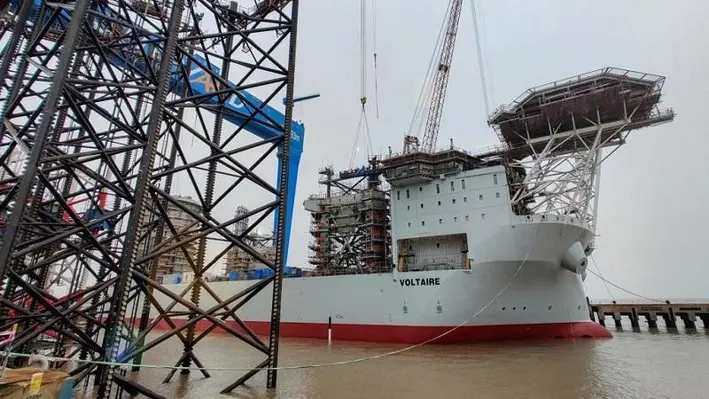

At the COSCO Shipping Shipyard in Nantong, China. Jan De Nul Group has launched the Voltaire, a next-generation offshore jack-up installation vessel for offshore renewables and decommissioning.
This vessel will be the second and largest jack-up vessel in Jan De Nul’s fleet and is due for delivery in H2 2022. Voltaire is built to transport, lift and install offshore wind turbines, transition pieces and foundations. The main crane with a capacity of over 3,000 tonnes will enable it to construct the current and future generation of wind farms at sea. Voltaire is ready for the future of offshore renewables, and will also be available to the oil and gas industry for the decommissioning of offshore structures.
The Voltaire is a jack-up vessel fitted with a high-tech jacking system. Four giant legs of 130 metres support the vessel to achieve stable working conditions at unsurpassed water depths up to 80 metres and with an elevated load of 16,000 tonnes. Compared to Jan De Nul’s other jack-up vessel Vole au vent, this new vessel has almost double the deck space.
Innovative design
The highly innovative main crane will be fitted with a Universal Quick Connector (UQC), developed by Huisman, and leveraging the expertise of Jan De Nul’s operational and engineering teams. The result is a innovative UQC, that will deliver a major step change in safer offshore lifting activities.
In common with Les Alizés, the Voltaire is equipped with a highly advanced dual exhaust filter system, removing up to 99% of nanoparticles from emissions using a diesel particulate filter (DPF) and reducing the NOx emissions and other pollutants by means of a selective catalytic reduction system (SCR) to levels in accordance with EU Stage V regulation. Together, these vessels will be the first two seaworthy installation vessels in the world with an extremely low carbon footprint.
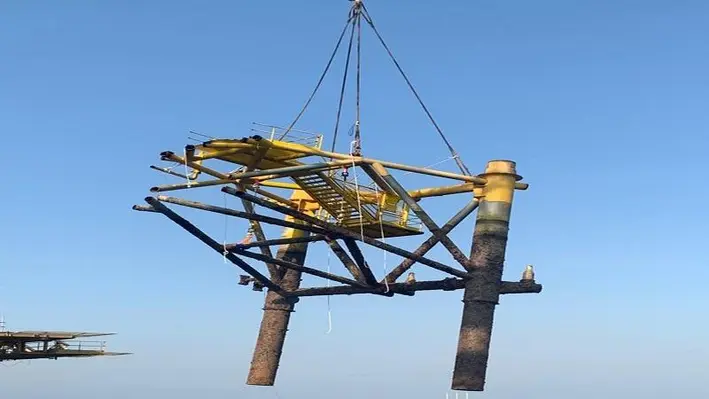

James Fisher, a leading provider of innovative marine solutions and specialised engineering services, has launched a new business line named James Fisher Decommissioning (JF Decom), which will support the decommissioning needs of customers in the renewables and oil and gas markets by delivering considerable cost and time saving solutions.
JF Decom will provide customers with access to a dedicated, multi-disciplined team that reduces the number of contractual interfaces, to provide an end-to-end service delivery capability in complex decommissioning scopes including: subsea infrastructure removal; structural removal, well severance, and well abandonment.
With one of the world’s largest fleets of decommissioning tooling and in-house design and engineering capability, JF Decom will be able to support the rise in decommissioning projects worldwide to deliver considerable cost and time saving solutions.
Jack Davidson, Managing Director at JF Decom commented, “Increasing demand for experienced decommissioning experts within the energy industry presents an opportunity for the group to focus on what it does best - providing tailored and pioneering solutions to address customer challenges.
“In addition to the challenges faced by customers to conduct decommissioning activities as timely and cost effectively as possible, JF Decom is also dedicated to ensuring that decommissioning is conducted as sustainably as possible by restoring the seabed to its natural state.”
In building its highly skilled team, JF Decom has utilised the extensive expertise of James Fisher Offshore, which has assisted operators in the installation and maintenance of oil and gas platforms - many of which will be decommissioned as the industry adapts to the energy transition. The in-depth knowledge of the differences between these platforms, allows JF Decom to deploy the most appropriate methodology and technology to optimise the delivery of a decommissioning project.
JF Decom’s services also include the innovative well abandonment tool SEABASS, a strategic investment made in 2021, that provides a more cost effective and quicker alternative to rig-based solutions when abandoning category 2 wells, due to its ability to deploy from a vessel of opportunity and work in any water depth.
Davidson added, “With our noise attenuation tools such as Bubble Curtains we can also minimise environmental impact to marine life during decommissioning works and ensuring we provide environmentally responsible services is something that is at the forefront for JF Decom.”
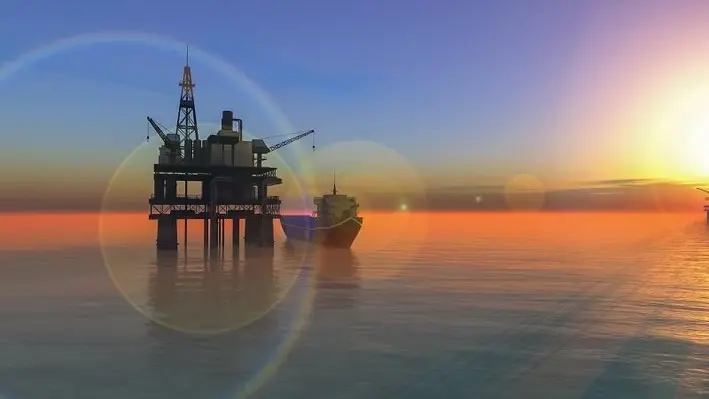

As it approaches the five-year anniversary of its first contract with PRT Offshore, Interventek Subsea Engineering has announced that it is shipping out their latest Revolution in-riser safety valve order.
This is for a new 4-1/8” 10,000psi, shear-seal valve, designed for slimline well access with an outer diameter of 15-1/8.
The slimline Revolution valve is the first of its kind and reflects a growing need for technology which is easily scalable to suit the individual challenges of different subsea intervention projects. Like all Interventek’s products, it has undergone extensive testing and meets the latest API 17G industry standards.
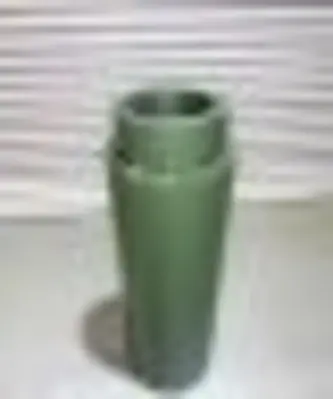
The valve will be used for intervention operations in the Gulf of Mexico in more than 2,450 m (8,000 ft) depth of water with an integral intervention arrangement, using a surface BOP for well control with direct vertical well access to the wet xmas trees below. The Interventek slimline valve will be used in conjunction with this arrangement to enable safe and efficient well access.
PRT Offshore already have an impressive fleet of eight additional Interventek Revolution valves in service, which have built up an extensive track record of deployments in the GOM over the last few years.


Ashtead Technology, an international subsea rental equipment and solutions specialist, has signed a multi-year agreement with Norway-based NORBIT Subsea, a provider of tailored and innovative technology solutions to the global maritime sector, to serve as its exclusive reseller throughout the Middle East.
NORBIT Subsea specialises in the design and development of high resolution wideband multibeam sonars for hydrographic applications, forward-looking applications and advanced subsea leakage detection. Based on the latest in analogue and digital signal processing, their products provide wide coverage monitoring combined with high sensitivity and accuracy.
David Mair, Ashtead Technology’s Business Development Director, commented, “We are delighted to partner with NORBIT Subsea for the exclusive sale of their multibeam sonar survey systems across the Middle East. These systems are industry-renowned for their exceptional performance, innovation and reliability and are in high demand with our customers.
“The Middle East is a key growth market for Ashtead Technology and we are excited to be able to broaden our product and service offering in the region and accelerate our international growth strategy.”
John Fraser, Director of NORBIT UK, added, “This exclusive agreement reinforces our commitment to the Middle East region and our plans for growth. We know Ashtead Technology very well and are delighted to be working together to continue building momentum for our products in the region.”
Ashtead Technology has also invested in NORBIT Subsea’s ultra-compact wideband multibeam sonars which offer high resolution bathymetry over a wide swath. These products are now available to rent throughout the company’s nine international technology and service hubs.
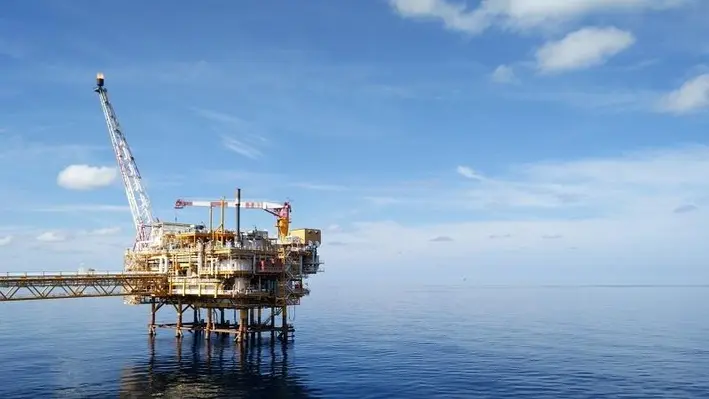

Serica Energy, a British independent oil and gas exploration and production company with a portfolio of exploration, development and production assets, has indicated its intention to pursue a well intervention campaign in the years to come.
In its recently published Corporate Update presentation for the year ended 31 December 2021, the company made the announcement alongside its intention to continue with its programme of through-cycle investment in its diversified portfolio of assets; drilling for the North Eigg exploration well in the summer of 2022; and its plans to grow cash balances to offer increasing options for futher investment, acquisition and distributions.
In the statement, the company wrote, “Plans are also in place for a well intervention campaign to take place in 2022 to improve the production potential of several Bruce and Keith wells during subsequent years.”
Bruce and Keith are two assets off the coast of the Orkney Islands. Together with Rhum, they provide a significant contribution to the UK gas demands and are estimated to contain net 2P reserves of 50.9 mmboe as of 01.01.21, of which more than 80% is gas.
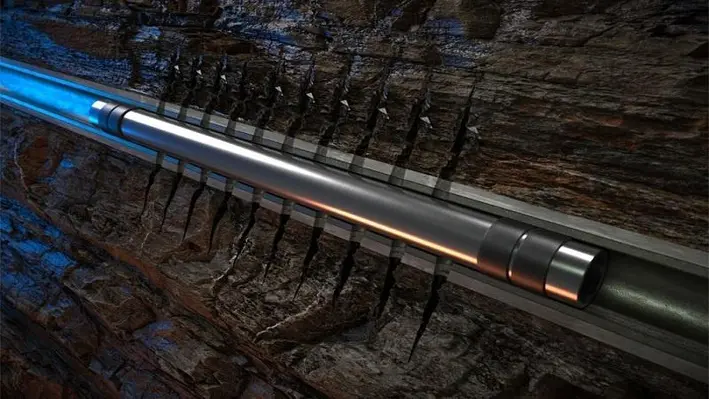

ReLineWL, the expandable technology designed to unlock greater commercial value by maximising production from existing wells, has been successfully deployed in the Middle East for the first time by developers Coretrax.
The global well integrity and production optimisation leader’s ReLineWL is a one-trip, wireline deployed straddle system to address common well integrity issues.
It is proven to deliver a 700% greater flow area when compared to traditional straddles, securing safety and sustainability benefits by reducing the number of onsite personnel required to complete the work.
Introduced in the Middle East for the first time, ReLineWL was deployed to support a major Saudi operator when water ingress on a producing well led to decreased oil recovery. Two ReLineWL 28ft straddles were deployed on e-line, enabling the operator to isolate several perforation intervals to shut off water production zones.
Compared to traditional tools, the ReLineWL’s outer diameter (OD) allowed the system to pass through restrictions before they were expanded and set at almost 7,000ft. The tool delivered a large post-expansion inner diameter, providing maximum production conduit to surface over conventional options.
The well was successfully brought back online with a 31% reduction in water production and additional oil production of 1,400bbls/day. With the requirement for surface water management also reduced the application also significantly reduced the operator’s carbon footprint.
John Fraser, Chief Executive Officer of Coretrax, commented, “The Middle East is a key growth area for Coretrax and the first deployment of our ReLineWL in the region is a significant milestone for the business as we continue to enhance our technology portfolio to support the most complex well integrity challenges. As operators remain focused on maximising recovery efficiently and sustainably, our expandable technology is ideally placed to support this demand.”
Available in various CRA materials, the tool can be configured to smart completion products such as autonomous inflow devices (AICDs) to enhance production by selectively eliminating gas and water production and provide a comprehensive workover solution.
The RelineWL has a high expansion ratio of 75% and is designed for stackability creating a longer, integrated straddle to be deployed, without losing ID. This also allows operators to gain access below if well intervention is required at a later date.
“The ReLineWL already has a proven track record in North America and I’m excited to see this successfully deployed in the Middle East for the first time. As we head into 2022, we already have a healthy pipeline of projects in the region and look forward to working closely with our customers to transform current well performance and deliver greater operational efficiencies,” Fraser continued.
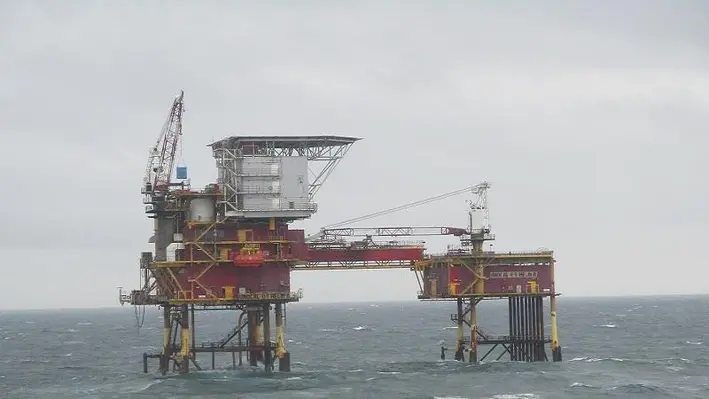

Petrogas E&P Netherlands B.V. (a part of Petrogas E&P LLC) has awarded Heerema an integrated engineering, preparation, removal, and disposal (EPRD) decommissioning contract for multiple North Sea oil platforms.
The work involves removing the Haven, Hoorn, Helm, and Helder platforms from Block Q1 of the Dutch sector in the southern North Sea.
Nick Dancer, Petrogas E&P Netherlands’ General Manager, remarked, “We are proud to have reached the 40th year of production with these assets, but the time has come to remove the platforms. This contract demonstrates Petrogas’ commitment to the safe and timely removal of our facilities and we are very pleased to have signed this contract with Heerema, whom we believe is the ideal partner for this project with their commitment to sustainability and circularity.”
The platforms have been important contributors to the Dutch oil and gas industry over the last 40 years, with the Helm platform being the first to produce oil on the Dutch continental shelf for the Dutch market. Their removal, which will take place over several years, is the final stage in a key part of the Netherlands' energy history.
Koos-Jan van Brouwershaven, Heerema's CEO, commented, “Heerema is proud to be Petrogas E&P Netherlands' chosen contractor for this significant decommissioning project. Our team is looking forward to working closely with Petrogas to prepare and execute the safe and sustainable decommissioning of these platforms. Heerema has installed the majority of North Sea platforms, and we believe in the circularity of removing these structures, leaving the sea as we found it. This action aligns with our own sustainable and circular ambitions to reuse and recycle wherever possible.”


TotalEnergies E&P Danmark has awarded Maersk Drilling a contract for well intervention services in the Danish North Sea.
Maersk will employ the high-efficiency jack-up rig Maersk Reacher to carry out the 21-month contract which is expected to commence in July 2022. The contract includes options to extend the duration by up to 27 additional months.
Maersk Reacher is a 350 ft, Gusto-engineered MSC CJ50 high-efficiency jack-up rig which was delivered in 2009. It is currently operating offshore Norway where it is scheduled to be replaced in a rig swap with Maersk Integrator end-February/early March 2022. Maersk Reacher will undergo a special periodic survey prior to commencing the contract with TotalEnergies.
Claus Bachmann, Head of North Sea Division in Maersk Drilling, commented, “We’re happy to build further on our long-standing collaboration with TotalEnergies by adding this long-term contract which means that two of our rigs will be working for TotalEnergies in Danish waters this year. Maersk Reacher will be available for the job after being released from its current work scope in Norway through the planned rig swap with Maersk Integrator.”
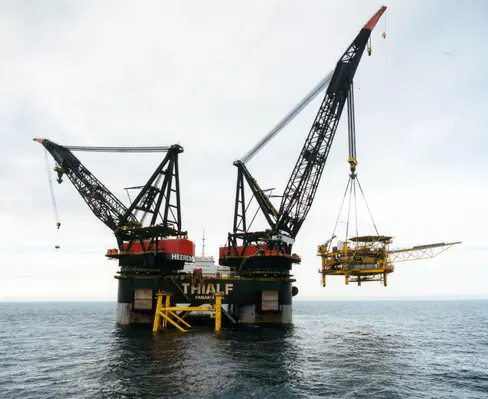

DNO has awarded a decommissioning contract to Heerema Marine Contractors for the integrated engineering, preparation, removal, and disposal (EPRD) of the Ketch and Schooner platforms.
The Ketch and Schooner platforms are located in the southern North Sea in the UK sector and were installed by Heerema in the 1990s. Both platforms are tied-back to the Murdoch complex, which will also be removed by Heerema Marine Contractors.
The Ketch platform is located in a water depth of 54 metres, and the Schooner platform is located at 71 metres of water depth. After removal, both structures will be responsibly disposed of and will be reused or recycled up to 97%.
Michel Hendriks, Heerema’s Decommissioning Director, commented, “Heerema is proud to be the contractor of choice for the decommissioning of the Ketch and Schooner platforms. The EPRD award is the result of our ambition to remove offshore structures of all sizes in a safe and sustainable manner.
“We are especially pleased to contribute to the circularity of the project by being the installation and removal contractor, which is in line with our own sustainable circular ambitions.”


Using Wire Arc Additive Manufacturing (WAAM), Vallourec has recently produced two lifting plugs for Weatherford with meet its urgent operational demands.
When Weatherford approached Vallourec with an urgent request for a VAM TTR HW Riser Lifting Plug capable of 100T for a customer’s workover scope off the coast of Australia, Vallourec proposed a more economical and faster solution using Additive Manufacturing (AM) in order to meet the deadline.
The lifting plugs were re-designed with WAAM to include tailor-made non-standard diameters that were compatible with Weatherford’s existing equipment. The lifting plugs’ outside diameter (OD) was therefore increased by 15% as per the customer’s request. Leveraging WAAM’s flexibility, Vallourec was able to mitigate any weight increase by re-designing the component without impacting lifting performances.
The 3D-printed safety-critical components weighed 175kg each with a tailor-made diameter of 50cm and were designed for load carrying applications of around 100 metric tons.
These new lifting plugs were 3D-printed with the Vallourec WAAM robot located in Singapore, only a six-hour flight away from the end-customer. The safety-critical components were delivered in just under two months instead of the usual three to four months.
“We approached Vallourec with an urgent request for a lifting plug for a customer of ours operating in the Timor Sea. Their solution was to use WAAM, a more economical and quicker option to the traditional route”, explained Shane Ferguson, Project Manager for Weatherford. “They executed this on time and delivery was made well before operations commenced. We were extremely happy with the finished product and will look to Vallourec and this method for future requirements.”
WAAM – and AM more widely – offers numerous benefits for the oil and gas industry, one of the most important being shorter, guaranteed lead times, which would make a huge difference to end users. WAAM also allows for greater freedom of shape – parts can be created to the exact size and specifications of each customer – as well as for printing of very large components. The ultimate benefit of this process is to allow companies to create a digital or virtual warehouse through which they can order spare parts as a printable file.
Thanks to WAAM, Vallourec is able to eliminate the traditional concerns regarding the unpredictability of material sourcing and minimum order quantity requirements, providing customers with solutions meeting their specific requirements any time.
“We look forward to making possible future projects such as this one, providing customers with the high quality they are used to from Vallourec with faster delivery times”, commented Jinwei Li, Asia Pacific Sales Manager at Vallourec.
Page 85 of 110